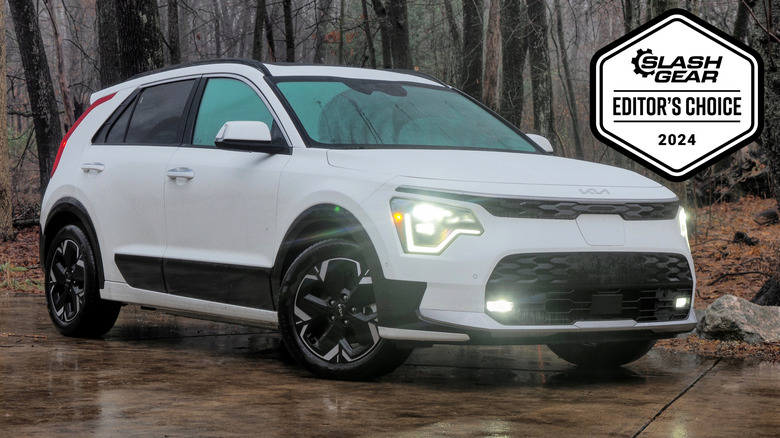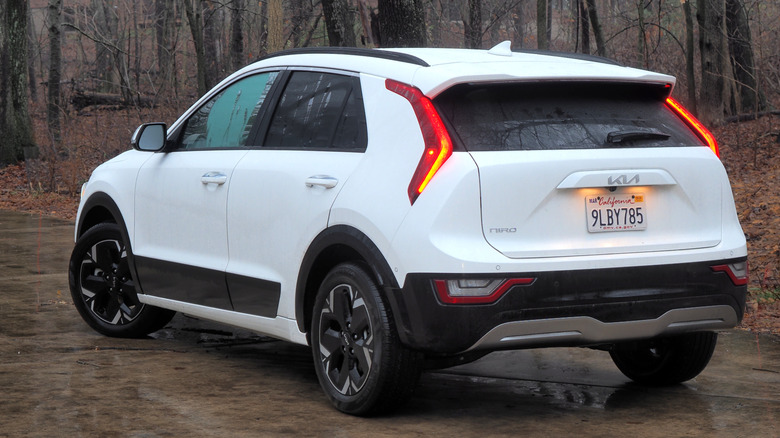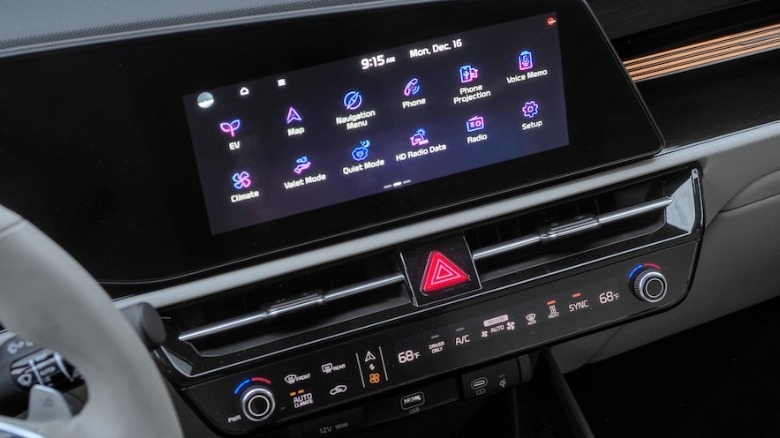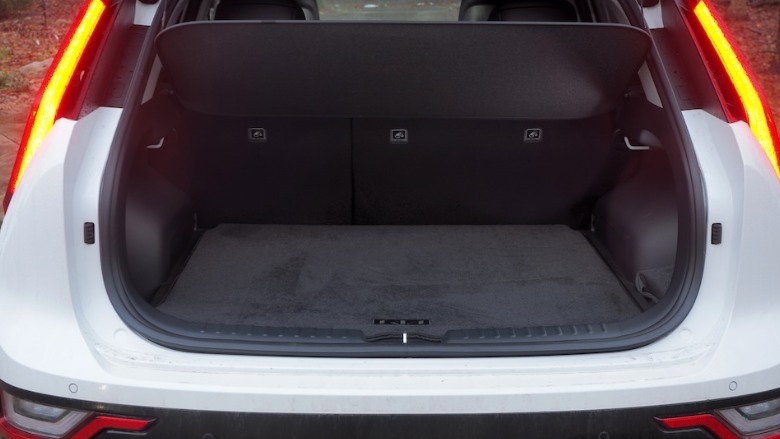2024 Kia Niro EV Review: Affordable Electric Car Doesn't Disappoint On Range
- Affordable and well-equipped
- Decent range
- Nippy urban fun
- No all-wheel drive option
- Slower DC fast charging than other EVs
Perhaps the most prescient of modern automakers when it comes to EV adoption, Kia hedged its electrification bets across a variety of drivetrains. So, the second generation Niro is available as a mild hybrid, a plug-in hybrid, and as this fully-electric 2024 Niro EV.
Want to save a little gas but not deal with plugging in? The base Niro Hybrid should do the trick. Have a home charger, but want the flexibility to fuel up at a gas station in a pinch? The Niro Plug-In Hybrid pairs its 33 mile electric-only range rating with a regular gas engine, for a strong balance of both worlds.
Most expensive — from $39,600 plus $1,375 destination, but before any relevant incentives — the 2024 Niro EV ousts internal combustion altogether. Instead, it promises up to 253 miles of electric-only driving on a full charge, plus it has the most power of the three, at 201 hp.
Two trims, one drivetrain
All three versions look broadly the same, chunky hatchbacks borrowing some crossover cues to presumably appeal in the more dominant segment. For the Niro EV, most of Kia's color options are variations on white, gray, or black, though there's a bright red and a handsome blue. The more expensive Wave trim (from $44,600 plus destination) can optionally be had in white with a contrasting "Aeroblade": the dogleg trim behind the rear door is finished in gray.
Regardless of whether you pick the Niro EV Wind or Wave trims, the drivetrain is the same. A single, permanent magnet synchronous electric motor sends 201 horsepower and 188 lb-ft of torque to the front wheels, powered by a 64.8 kWh battery.
Steering wheel paddles switch the Niro EV through four levels of regenerative braking intensity, from none whatsoever all the way to one-pedal driving. Annoyingly, the latter isn't latching: power-cycle the car, and at most the Kia will return to its second-most-intense regen level. Equally tedious, at times you clack the paddle to re-enable it, only to get a "driving conditions are not met" warning on the display.
Not a fast EV, but it's not meant to be
It's hard to criticize the Niro EV's performance, given its price and Kia's positioning. It's perky rather than outrageous, nimble enough to zip through urban traffic. EV-makers traditionally get upset when you compare their cars to golf carts, and yet the little Kia epitomizes what makes them such a hoot to drive: spritely acceleration and direct-feeling (if plenty power-assisted) steering.
A button on the steering wheel switches through Eco, Normal, Sport, and Snow modes. The former trades zip for the promise of greater range, though definitely leaves the Niro EV feeling on the sluggish side. Normal and Sport, meanwhile, are far more fun. The Kia feels planted and stable, though then again so it ought to with a roughly 3,800 pound curb weight. With mixed driving, I saw 3.1 miles per kWh: not bad at all, given it's winter and I wasn't sparing the creature comforts.
My biggest complaint is the absence of an all-wheel drive option. If you want, or need, all four wheels to be driven — such as because you live in a cold weather state and the Snow mode isn't quite doing the job – then the Niro EV is not the electric car for you. Instead, Kia will point you in the direction of the bigger and more expensive EV6: it starts at $42,600, though you'll spend at least $49,850 (both prices before destination) to get an AWD configuration.
A comfortable and well-equipped cabin
I can't really fault Kia's positioning, there. A single-motor Tesla Model 3, for instance, is from $42,490 plus destination, though has a significantly higher range estimate than the Niro EV. Fiat's diminutive 500e starts at $32,500 plus destination, is single-motor only, and only has 163 miles of range. A Nissan Leaf SV Plus starts at $36,190 in single-motor form, but with 212 miles of range.
Of that quartet, I prefer the Niro EV's interior, too. Familiar from the rest of Kia's range, with sizable screens — dual 10.25-inch panels are standard on both trims — but still plenty of physical controls. The most tedious part is the touch-sensitive row of switchgear that toggles between adjusting the dual-zone climate control and the multimedia, and which you can't really use fully without glancing down from the road.
Apple CarPlay and Android Auto are standard, though only wired, not wireless. The Wind gets a six-speaker audio system, upgraded to an eight-speaker Harman Kardon version in the wave. Both have USB-A and USB-C ports up front, and twin USB-A ports in the rear, plus a 12V outlet; sadly, there's no inside AC outlet.
Plenty of active safety tech
Both trims get a power-adjustable driver's seat, front seat heating, and SynTex upholstery. The Wave adds a heated steering wheel and ventilated front seats, plus a power sunroof; both trims offer heated rear seats as an option. It's included in the "Preserve" package — not fitted to this particular review car — which also includes a heat pump for better cold weather battery performance.
Standard on Wind and Wave trims are lane-keeping and lane-following assist, plus adaptive cruise control, blind spot warnings, and forward collision avoidance assist with pedestrian, cyclist, and junction-turning detection. Highway Driving Assist (HDA) is standard on the Wind; the Wave upgrades that to HDA2.
Space in the front is ample, with plenty of storage nooks. The rear is a little more cramped, unsurprisingly given the footprint, but not unduly so for the segment. The trunk — with a power liftgate on both trims — holds a decent 22.8 cu-ft with the rear seats up (less than 1 cu-ft under the Leaf). Fold them down, and that expands to 63.7 cu-ft.
2024 Kia Niro EV Verdict
As for charging, the Niro EV hides its CCS port behind a hatch in the center of the front grille. Kia says a 10-80% charge at a DC fast charger will take a lethargic 43 minutes: an EV6 will do the same in just 18 minutes. Come early 2025, and Kia says Niro EV owners will have Tesla Supercharger access (albeit with an adapter required for the NACS plug).
I suspect most Niro EV owners will charge at home, though, rather than head out on road trips. The little Kia seems destined to be an urban runaround, a task at which it does just fine. Nimble enough to leave most traffic in its wake, small enough to be easy to park (rear parking sensors are standard, and the Wave gets front sensors and remote parking assist), and capacious enough for kids and the weekly grocery shop.
No, it won't scalp you with Lucid-levels of acceleration, nor turn heads like a VW ID. Buzz. Not every electric car needs to. Only the absence of all-wheel drive really spoils the Niro EV, but for those who just want simple transportation and don't have to worry about snow, the positives well outweigh the negatives.












